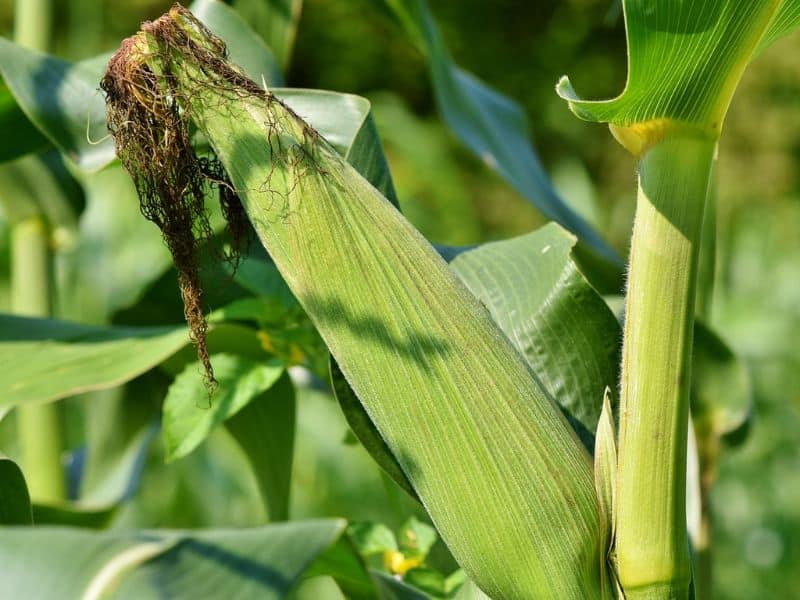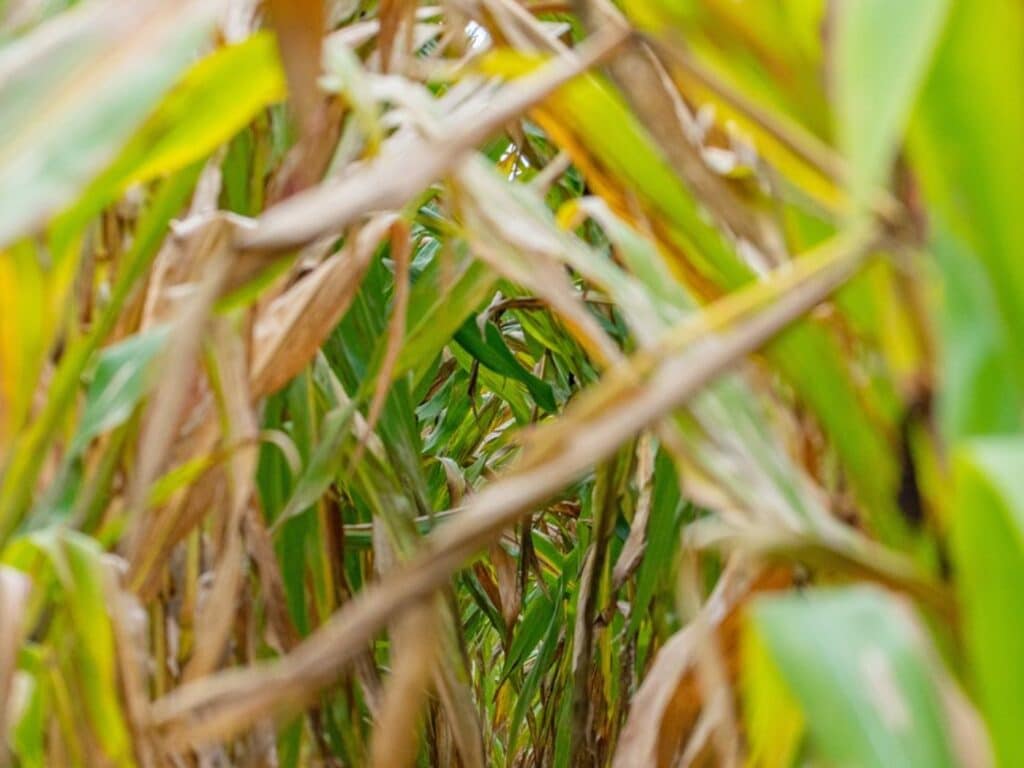Discovering your corn plant’s leaves turning brown and yellow can be disheartening. These symptoms often point to underlying issues that, if left unchecked, can compromise the health and beauty of your plant.
Fortunately, understanding the root causes and implementing the right solutions can turn things around. This article is designed to guide you through the process of diagnosing the problem and offering practical steps to restore your corn plant’s vibrant green foliage.
Whether you’re a seasoned gardener or a novice plant parent, the insights here will empower you to take action and help your plant thrive once again. Let’s dive into the world of plant care and unravel the mystery behind those brown and yellow leaves.
Understanding Corn Plant Health
The Importance of Leaf Color
Leaf color acts as a dashboard displaying the health status of your corn plant. Think of it like a traffic light; green signals all is well, while yellow or brown may well mean it’s time to pump the brakes and check under the hood.
Persistent vibrant green leaves indicate a happy, healthy plant absorbing adequate sunlight and nutrients. Conversely, browning or yellowing can raise a flag that something’s off, perhaps in the environment or with the plant’s care routine.
Indicators of Problems in Corn Plants
When your corn plant’s leaves start flaunting hues of yellow and brown, it’s broadcasting a distress signal. These discolorations are symptoms, often hinting at issues such as water stress, nutrient deficiencies, or even diseases and pests.
Water stress can stem from both underwatering and overwatering, with the former leaving your plant parched and the latter leading to root rot. Nutrient issues, conversely, could be a cry for more nitrogen or iron.
Lastly, diseases like fungal infections or pests such as spider mites also manifest through leaf color changes, demanding immediate attention to prevent further damage. Recognizing these indicators lets you act promptly, restoring your corn plant’s health and ensuring its continued growth.
Causes of Corn Plant Leaves Turning Brown and Yellow

When your corn plant starts looking more like an autumn display than a vibrant indoor greenery, it’s time to play plant detective. The signs you’re seeing on the leaves can help you diagnose and fix the problem, ensuring your plant gets back to its glossy green self.
Watering Issues
Ironically, both underwatering and overwatering can turn your corn plant’s leaves brown and yellow. Underwatering leaves the plant thirsty, causing the leaves to dry out and turn brown.
On the flip side, overwatering can drown the roots, preventing them from absorbing oxygen and turning the leaves yellow. Check the soil moisture; it should feel damp, not waterlogged or desert-dry.
Nutrient Deficiencies
Like you on a diet missing essential nutrients, your corn plant can look a bit worse for wear without its dietary needs met. A lack of essential nutrients such as nitrogen, potassium, and magnesium will manifest in the leaves turning yellow.
Consider using a balanced fertilizer, but don’t overdo it—a little goes a long way to green up those leaves.
Lighting Conditions
Corn plants love light, but not too much. Direct sunlight can scorch the leaves, turning them brown, while too little light can fade them to yellow. Finding that Goldilocks zone of bright, indirect light will have your corn plant soaking up the rays without any crispy consequences.
Pest Infestations
Imagine coming home to find uninvited guests munching on your dinner. That’s how your corn plant feels about pests. Spider mites, mealybugs, and scale insects view your plant as an all-you-can-eat buffet, damaging the leaves and turning them yellow or brown. Keep an eye out for these pests and introduce them to their least favorite thing: insecticidal soap.
Disease and Fungal Problems
Last but not least, diseases and fungi love a plant in distress. Issues like root rot and fungal infections thrive in overly wet soil, leading to brown or yellow leaves. If you suspect disease, it’s time to play surgeon—remove the affected parts, ensure good air circulation, and adjust your watering habits to keep the soil from staying too wet.
Remember, a little attention goes a long way. By addressing these issues, you’ll not only save your corn plant from turning into a fall foliage display but also ensure its place as a dazzling green centerpiece in your home.
Best Practices for Preventing Discoloration
Proper Watering Techniques
Getting your watering technique right is crucial for keeping those corn plant leaves green and happy. Overwatering and underwatering are equally harmful. Strike a balance by allowing the top inch of soil to dry out before watering again.
Consider the season too. Your plant will likely need more water during the warmer months and less during the cooler ones. Remember, your corn plant prefers consistency, so try to keep its watering schedule as regular as your morning coffee.
Ideal Lighting and Temperature
Corn plants are a bit like Goldilocks, not too fond of light that’s too bright or too dim, and they dislike temperatures that are too hot or too cold. They thrive in moderate, indirect sunlight and enjoy temperatures between 60-75°F (15-24°C).
Place your plant in a spot where it can enjoy filtered sunlight, perhaps near a window with sheer curtains. This setup mimics its natural habitat and keeps those leaves from turning into a crispy snack.
Soil Nutrition Management
The right soil mix does more than just hold your plant upright; it feeds it. A well-draining, loamy soil enriched with organic matter is your best bet. Consider topping up the essential nutrients with a balanced, slow-release fertilizer during the growing season, usually in spring and summer.
However, don’t get carried away with the feed—too much love in the form of fertilizer can cause more harm than good, leading to nutrient burn.
Regular Monitoring and Maintenance
Finally, keep an eye on your corn plant like it’s the season finale of your favorite show. Regular checks can help you catch any signs of trouble early, be it browning leaves or an unexpected pest party.
Clean the leaves occasionally to prevent dust accumulation, which can block sunlight. Also, don’t shy away from pruning dead or yellowing leaves to encourage new growth. It may well seem a bit harsh, but your plant will thank you for it by flourishing.
Treatment and Recovery
Adjusting Watering Schedules
If your corn plant’s leaves are turning brown or yellow, it’s time for a water schedule makeover. Start by watering only when the top inch of soil feels dry. This simple trick prevents both overwatering and underwatering, common culprits in the discoloration drama.
Remember, your corn plant prefers a drink before a drought, but it hates soggy feet. As seasons change, so should your watering habits—less in winter, more in summer.
Addressing Nutritional Shortfalls
Yellow leaves may well be your corn plant’s way of saying it’s hungry. To banish those nutritional blues, incorporate a balanced, slow-release fertilizer into its diet every few months. This is especially crucial from spring through summer when your plant is in its growth spurt.
Think of it as a multivitamin for your green buddy, providing all the essential nutrients it craves for vibrant leaves and robust health.
Managing Light Exposure
Too much sun can turn a corn plant into the plant equivalent of a sunburned tourist, while too little leaves it languishing in the shadows.
Aim for the sweet spot of moderate, indirect sunlight. If you notice the leaves getting scorched, pull it back from the window. On the flip side, if it’s stretching out and looking a bit pale, it may well be craving more light. Sometimes, a small shift in location makes all the difference.
Controlling Pests and Diseases
Last but not least, keep an eye out for uninvited guests. Pests and diseases love to feast on stressed plants. Regular inspections for telltale signs, such as sticky residue or discolored spots, can help you catch issues early.
If you do spot trouble, a gentle insecticidal soap or neem oil treatment can work wonders. Prevention, as they say, is better than cure—keep your plant clean and happy to ward off pests and diseases before they settle in.
When to Seek Professional Help
Identifying Serious Plant Health Issues
Recognizing when your corn plant needs a professional’s touch starts with observing signs that go beyond normal care adjustments. If the leaves continue to turn brown and yellow despite following all recommended care practices, including proper watering, lighting, and fertilization, it may well be time to call in the experts.
Diseases like root rot or pest infestations such as spider mites can be tricky to combat without specific knowledge or products. Persistent problems that resist your best efforts indicate an underlying issue that requires a more experienced approach.
Finding Expert Resources and Solutions
Locating the right expert for your corn plant doesn’t have to be a chore. Start with local nurseries or garden centers; often, the staff there possess a wealth of knowledge and can provide immediate, actionable advice.
For more severe issues, a certified arborist or a plant pathologist may well be necessary. These professionals can offer diagnostic services to pinpoint the exact problem, leading to more effective treatment plans.
Additionally, online forums and gardening communities can be valuable resources, offering insights and recommendations based on similar experiences. Remember, acting quickly can save your plant and bring it back to its lush, vibrant state.
Frequently Asked Questions
What causes brown and yellow leaves on corn plants?
Brown and yellow leaves on corn plants can be a sign of several issues, including water stress, nutrient deficiencies, pests, improper lighting conditions, and diseases. Proper identification is key to addressing the problem.
How should I water my corn plant for optimal health?
Water your corn plant thoroughly, allowing the top inch of soil to dry out between waterings. Avoid overwatering which can lead to root rot, and under-watering which can stress the plant, leading to brown or yellow leaves.
What are the ideal lighting and temperature conditions for corn plants?
Corn plants thrive in bright, indirect light and prefer temperatures between 60 to 75°F (15 to 24°C). Avoid placing them in direct sunlight or areas with drastic temperature changes or drafts.
When should I seek professional help for my corn plant?
If your corn plant continues to show leaf discoloration despite adjusting your care routine, it’s time to consult with experts. Local nurseries, certified arborists, or plant pathologists can provide specific diagnoses and treatment options.
How important is soil nutrition for corn plant health?
Soil nutrition is crucial for the health of corn plants. Ensure the soil is well-draining and nutrient-rich. Periodic fertilization, according to the plant’s growth phase, can help maintain optimal health and prevent nutrient deficiencies.
Up next:







